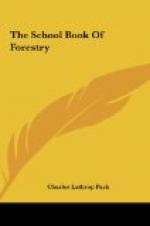The timber in the Tongass National Forest runs 60 per cent. western hemlock and 20 per cent. Sitka spruce. The other 20 per cent. consists of western red cedar, yellow cypress, lodge-pole pine, cottonwood and white fir. The yellow cypress is very valuable for cabinet making. All these species except the cedar are suitable for pulp manufacture. Peculiarly enough, considerable of the lumber used in Alaska for box shooks in the canneries and in building work is imported from the United States. The local residents do not think their native timber is as good as that which they import.
Alaska will probably develop into one of the principal paper sources of the United States. Our National Forests in Alaska contain approximately 100,000,000 cords of timber suitable for paper manufacture. Experts report that these forests could produce 2,000,000 cords of pulpwood annually for centuries without depletion. About 6,000,000 tons of pulpwood annually are now required to keep us supplied with enough paper. The Tongass National Forest could easily supply one-third of this amount indefinitely. This forest is also rich in water power. It would take more than 250,000 horses to produce as much power as that which the streams and rivers of southern Alaska supply.
The western hemlock and Sitka spruce are the best for paper making. The spruce trees are generally sound and of good quality. The hemlock trees are not so good, being subject to decay at the butts. This often causes fluted trunks. The butt logs from such trees usually are inferior. This defect in the hemlock reduces its market value to about one-half that of the spruce for paper making. Some of the paper mills in British Columbia are now using these species of pulpwood and report that they make high-grade paper.
The pulp logs are floated down to the paper mill. In the mill the bark is removed from the logs. Special knives remove all the knots and cut the logs into pieces twelve inches long and six inches thick. These sticks then pass into a powerful grinding machine which tears them into small chips. The chips are cooked in special steamers until they are soft. The softened chips are beaten to pieces in large vats until they form a pasty pulp. The pulp is spread over an endless belt of woven wire cloth of small mesh. The water runs off and leaves a sheet of wet pulp which then is run between a large number of heated and polished steel cylinders which press and dry the pulp into sheets of paper. Finally, it is wound into large rolls ready for commercial use.
If a pulp and paper industry is built up in Alaska, it will be of great benefit to that northern country. It will increase the population by creating a demand for more labor. It will aid the farming operations by making a home market for their products. It will improve transportation and develop all kinds of business.




